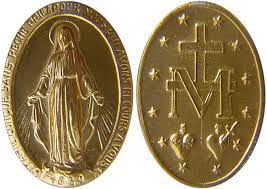In the heart of 1830 Paris, a series of extraordinary events unfolded at the Rue du Bac, culminating in the creation of one of the most cherished sacramentals of the Catholic faith: the Miraculous Medal. The story behind this sacred medal begins with a humble nun, Saint Catherine Labouré, and her divine encounters with the Blessed Virgin Mary, which left an indelible mark on Christian spirituality.
The Apparitions
On the night of July 18, 1830, Catherine Labouré, a novice at the Daughters of Charity convent, was roused from sleep by a child's voice, urging her to the chapel. There, she witnessed a life-altering vision: the Virgin Mary, seated in resplendent glory. This first apparition set the stage for the more significant revelations to come.
On November 27, 1830, Mary appeared again, standing on a globe, with rays of light streaming from her hands towards the earth. This vision is the heart of the Miraculous Medal's story. Mary instructed Catherine to have a medal struck according to the vision, promising great graces to those who would wear it with faith. Our Lady said: "Have a medal struck upon this model. Those who wear it will receive great graces, especially if they wear it around the neck." This directive underscored the medal's importance as a sacramental, a tool for drawing closer to God through Mary's intercession.
Our Lady also conveyed messages emphasizing prayer, penance, and the importance of wearing the medal as a tangible reminder of her protection and intercession. Our Lady said: "The whole world will be overwhelmed by miseries of all kinds... But come to the foot of this altar. There, graces will be poured out on all who ask with confidence and fervor." This invitation to trust and prayer is at the core of the medal's spiritual legacy.
The Design and Symbolism of the Miraculous Medal
The Miraculous Medal is not only remarkable for its origin but also for its intricate design, each element rich with symbolism.
The Front Side. The image of Our Lady standing on a globe, with rays of light emanating from her hands, symbolizes her as the Mediatrix of All Graces, dispensing God's blessings to the world. The inscription, "O Mary, conceived without sin, pray for us who have recourse to thee," affirms her Immaculate Conception, a dogma declared 24 years after the apparitions.
The Reverse Side. This side of the medal depicts a cross intertwined with the letter M, representing Mary's close association with Jesus' sacrifice. Below it, the Sacred Heart of Jesus and the Immaculate Heart of Mary, side by side, signify their united love for humanity. The twelve stars encircling the design echo the image of Mary as the Woman of the Apocalypse, crowned with stars and signifying her universal queenship and protection.
The Miraculous Medal serves as a reminder of Mary's promise to assist those who seek her help and wear the medal with faith. Millions around the world testify to the graces received through this simple yet profound sacramental, making it a testament to the living relationship between Heaven and Earth.
Conclusion
The story of the Miraculous Medal is a story of faith, hope, and divine promise. Through Saint Catherine Labouré's visions, the Blessed Virgin Mary provided humanity with a tangible symbol of her maternal care and intercession. The medal's enduring legacy is a testament to the power of faith and the countless graces bestowed upon those who wear it with confidence in Mary's promise. It stands as a beacon of hope, encouraging all to seek refuge in the love and protection of Our Lady. Oh Mary, conceived without original sin, pray for us who have recourse to thee!

